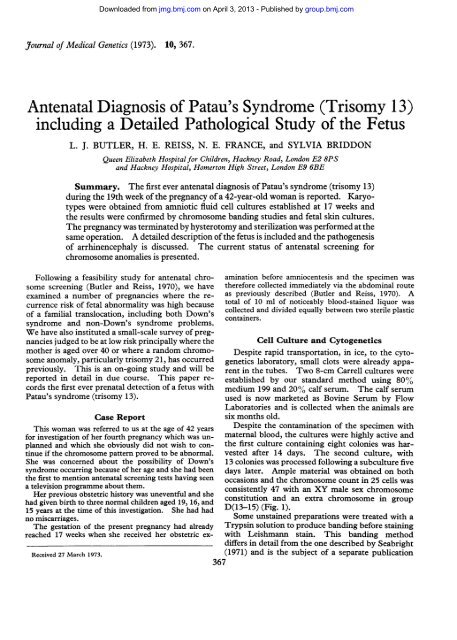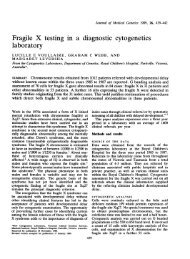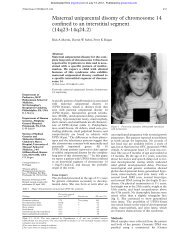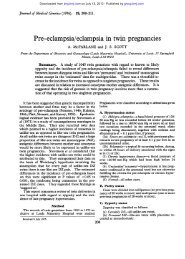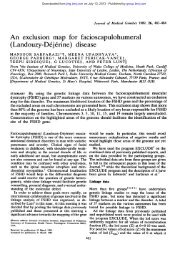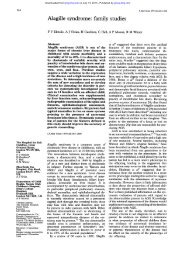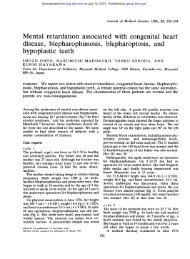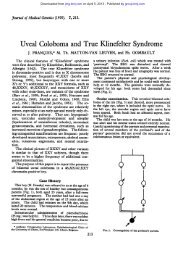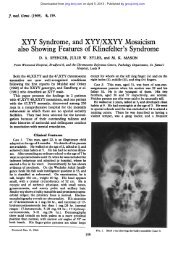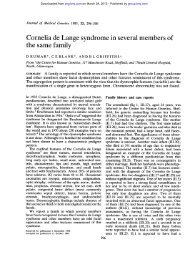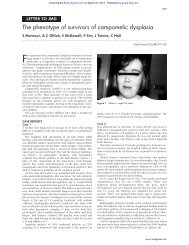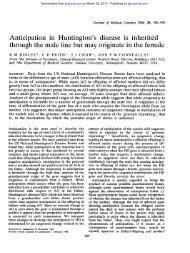Antenatal Diagnosis of Patau's Syndrome (Trisomy 13) including a ...
Antenatal Diagnosis of Patau's Syndrome (Trisomy 13) including a ...
Antenatal Diagnosis of Patau's Syndrome (Trisomy 13) including a ...
You also want an ePaper? Increase the reach of your titles
YUMPU automatically turns print PDFs into web optimized ePapers that Google loves.
Journal <strong>of</strong> Medical Genetics (1973). 10, 367.<br />
<strong>Antenatal</strong> <strong>Diagnosis</strong> <strong>of</strong> <strong>Patau's</strong> <strong>Syndrome</strong> (<strong>Trisomy</strong> <strong>13</strong>)<br />
<strong>including</strong> a Detailed Pathological Study <strong>of</strong> the Fetus<br />
L. J. BUTLER, H. E. REISS, N. E. FRANCE, and SYLVIA BRIDDON<br />
Queen Elizabeth Hospital for Children, Hackney Road, London E2 8PS<br />
and Hackney Hospital, Homerton High Street, London E9 6BE<br />
Summary. The first ever antenatal diagnosis <strong>of</strong> <strong>Patau's</strong> syndrome (trisomy <strong>13</strong>)<br />
during the 19th week <strong>of</strong> the pregnancy <strong>of</strong> a 42-year-old woman is reported. Karyotypes<br />
were obtained from amniotic fluid cell cultures established at 17 weeks and<br />
the results were confirmed by chromosome banding studies and fetal skin cultures.<br />
The pregnancy was terminated by hysterotomy and sterilization was performed at the<br />
same operation. A detailed description <strong>of</strong>the fetus is included and the pathogenesis<br />
<strong>of</strong> arrhinencephaly is discussed. The current status <strong>of</strong> antenatal screening for<br />
chromosome anomalies is presented.<br />
Following a feasibility study for antenatal chrosome<br />
screening (Butler and Reiss, 1970), we have<br />
examined a number <strong>of</strong> pregnancies where the recurrence<br />
risk <strong>of</strong> fetal abnormality was high because<br />
<strong>of</strong> a familial translocation, <strong>including</strong> both Down's<br />
syndrome and non-Down's syndrome problems.<br />
We have also instituted a small-scale survey <strong>of</strong> pregnancies<br />
judged to be at low risk principally where the<br />
mother is aged over 40 or where a random chromosome<br />
anomaly, particularly trisomy 21, has occurred<br />
previously. This is an on-going study and will be<br />
reported in detail in due course. This paper records<br />
the first ever prenatal detection <strong>of</strong> a fetus with<br />
<strong>Patau's</strong> syndrome (trisomy <strong>13</strong>).<br />
Case Report<br />
This woman was referred to us at the age <strong>of</strong> 42 years<br />
for investigation <strong>of</strong> her fourth pregnancy which was unplanned<br />
and which she obviously did not wish to continue<br />
if the chromosome pattern proved to be abnormal.<br />
She was concerned about the possibility <strong>of</strong> Down's<br />
syndrome occurring because <strong>of</strong> her age and she had been<br />
the first to mention antenatal screening tests having seen<br />
a television programme about them.<br />
Her previous obstetric history was uneventful and she<br />
had given birth to three normal children aged 19, 16, and<br />
15 years at the time <strong>of</strong> this investigation. She had had<br />
no miscarriages.<br />
The gestation <strong>of</strong> the present pregnancy had already<br />
reached 17 weeks when she received her obstetric ex-<br />
Received 27 March 1973.<br />
Downloaded from<br />
jmg.bmj.com on April 3, 20<strong>13</strong> - Published by group.bmj.com<br />
amination before amniocentesis and the specimen was<br />
therefore collected immediately via the abdominal route<br />
as previously described (Butler and Reiss, 1970). A<br />
total <strong>of</strong> 10 ml <strong>of</strong> noticeably blood-stained liquor was<br />
collected and divided equally between two sterile plastic<br />
containers.<br />
Cell Culture and Cytogenetics<br />
Despite rapid transportation, in ice, to the cytogenetics<br />
laboratory, small clots were already apparent<br />
in the tubes. Two 8-cm Carrell cultures were<br />
established by our standard method using 80%<br />
medium 199 and 20% calf serum. The calf serum<br />
used is now marketed as Bovine Serum by Flow<br />
Laboratories and is collected when the animals are<br />
six months old.<br />
Despite the contamination <strong>of</strong> the specimen with<br />
maternal blood, the cultures were highly active and<br />
the first culture containing eight colonies was harvested<br />
after 14 days. The second culture, with<br />
<strong>13</strong> colonies was processed following a subculture five<br />
days later. Ample material was obtained on both<br />
occasions and the chromosome count in 25 cells was<br />
consistently 47 with an XY male sex chromosome<br />
constitution and an extra chromosome in group<br />
D(<strong>13</strong>-15) (Fig. 1).<br />
Some unstained preparations were treated with a<br />
Trypsin solution to produce banding before staining<br />
with Leishmann stain. This banding method<br />
differs in detail from the one described by Seabright<br />
(1971) and is the subject <strong>of</strong> a separate publication<br />
67
368<br />
Downloaded from<br />
jmg.bmj.com on April 3, 20<strong>13</strong> - Published by group.bmj.com<br />
i-111111''''''''''''11<br />
1 9 -.. C<br />
1 ---5<br />
Butler, Reiss, France, and Briddon<br />
1 ii'II-<br />
b&<br />
- C _ .......4.... i4<br />
FIG. 1. Partial karyotype <strong>of</strong> a cultured amniotic fluid cell showing the Y chromosome in group G and an extra autosome at position <strong>13</strong>.<br />
d. _<br />
FIG. 2. The D(<strong>13</strong>-15) group from a similar cell treated with trypsin to reveal banding. The pattern is consistent<br />
with a diagnosis <strong>of</strong> trisomy <strong>13</strong>.<br />
which is in preparation. The banding patterns observed<br />
were consistent with a diagnosis <strong>of</strong> trisomy <strong>13</strong><br />
(Fig. 2).<br />
These results were subsequently confirmed using<br />
cultures <strong>of</strong> fetal skin.<br />
Management <strong>of</strong> Pregnancy<br />
The patient was informed immediately <strong>of</strong> the<br />
findings and she elected to have a termination by<br />
abdominal hysterotomy so that she could be sterilized<br />
by tubal ligation at the same time. This was<br />
performed at 20 weeks and the fetus in the intact<br />
gestation sac was removed with minimum damage<br />
for detailed pathological examination. The<br />
patient's postoperative progress was uneventful.<br />
A. Lit<br />
Ac,<br />
a<br />
Necropsy <strong>of</strong> Fetus<br />
The fetus was male and moderately hydropic<br />
(Fig. 3). The weight (442 g), and crown-rump<br />
length (16-5 cm) corresponded to a gestational age <strong>of</strong><br />
about 20 weeks. Over the vertex there was an area<br />
<strong>of</strong> apparent aplasia <strong>of</strong> the scalp measuring 1P9 x<br />
1 2 cm. Microscopically it was sharply differentiated<br />
from the surrounding normal immature<br />
skin and consisted <strong>of</strong> a thin layer <strong>of</strong> avascular myxomatous<br />
tissue the surface <strong>of</strong> which was covered by a<br />
single layer <strong>of</strong> cuboidal epithelium. No accessory<br />
skin organs were present. The ears were lowset but<br />
not otherwise abnormal and the upper lip was long<br />
with a clearly marked filtrum. The posterior half<br />
<strong>of</strong> the hard and s<strong>of</strong>t palate was cleft. There was a
Downloaded from<br />
jmg.bmj.com on April 3, 20<strong>13</strong> - Published by group.bmj.com<br />
<strong>Antenatal</strong> <strong>Diagnosis</strong> <strong>of</strong> <strong>Patau's</strong> <strong>Syndrome</strong> (<strong>Trisomy</strong> <strong>13</strong>)<br />
FIG. 3. Male fetus with a number <strong>of</strong> facial features <strong>of</strong> <strong>Patau's</strong> syndrome.<br />
Note also cystic hygroma <strong>of</strong> the right side <strong>of</strong> the neck, polydactyly,<br />
and talipes equino-varus.<br />
large cystic hygroma <strong>of</strong> the right side <strong>of</strong> the neck<br />
extending into the right cheek composed <strong>of</strong> cysts up<br />
to 1 cm in diameter lined by endothelium and containing<br />
yellowish watery fluid. The thorax was<br />
wide and the sternum relatively short. A small<br />
extra digit was present on the ulnar aspect <strong>of</strong> each<br />
hand but there were no obvious flexion deformities.<br />
Both feet showed talipes equino-varus.<br />
Cardiovascular System. There was an ostium<br />
secundum defect <strong>of</strong> the atrial septum with a high<br />
ventricular septal defect and severe stenosis <strong>of</strong> the<br />
pulmonary valve. The aorta arose completely from<br />
the right ventricle with the aortic valve situated behind<br />
the pulmonary valve. The ductus arteriosus<br />
was atretic. Both umbilical arteries were present.<br />
There were several subcapsular foci <strong>of</strong> calcification<br />
<strong>of</strong> the liver particularly <strong>of</strong> the left lobe. Microscopically<br />
each focus was surrounded by connective<br />
tissue usually <strong>including</strong> several bile ducts and blood<br />
369<br />
vessels. It is probable that calcification followed<br />
necrosis <strong>of</strong> unknown aetiology.<br />
There was a deficiency <strong>of</strong> the anterior part <strong>of</strong> the<br />
left kidney exposing the renal pelvis but otherwise<br />
both kidneys were normal.<br />
The brain weighed 39 g. Although its general<br />
appearance was consistent with the gestational age,<br />
neither olfactory tract was visible to the naked eye<br />
contrasting with the relative prominence in a normal<br />
brain <strong>of</strong> similar maturity where they have a diameter<br />
in the region <strong>of</strong> 0 3 cm. At the proximal end <strong>of</strong><br />
each cribriform plate there was a small pale nodule<br />
about 0-1 cm diameter which was shown microscopically<br />
to represent the olfactory bulb. The<br />
ethmoid and the anterior part <strong>of</strong> the sphenoid<br />
<strong>including</strong> both nasal cavities were sectioned serially<br />
in the coronal plane. All sections showed a very<br />
thin olfactory tract on each side <strong>of</strong> the midline; these<br />
were closely applied to the periosteum <strong>of</strong> the ethmoid<br />
bone and received nerves directly from the epithelium<br />
lining the nasal cavities. On the medial<br />
aspect <strong>of</strong> each olfactory tract there was a small mass<br />
composed <strong>of</strong> nerve cells and fibres. Numerous<br />
axons were demonstrated by Holme's stain in the<br />
region <strong>of</strong> these mitral cells but only occasional<br />
axons were stained in the olfactory nerves and olfactory<br />
tracts.<br />
All other organs <strong>including</strong> the eyes were normal.<br />
Discussion<br />
Since 1967, when the first practical antenatal<br />
chromosome study was made, there has been a steady<br />
improvement in the relative success rate <strong>of</strong> cell culture<br />
for fetal karyotyping so that the leading centres<br />
throughout the world are now able to <strong>of</strong>fer a 90%<br />
certainty <strong>of</strong> obtaining a result (Butler, 1972). Despite<br />
this improvement, the number <strong>of</strong> pregnancies<br />
screened during this four- to five-year period is still<br />
relatively small and the series <strong>of</strong> Nadler and Gerbie<br />
(1971) remains the largest on record. The experience<br />
<strong>of</strong> Ferguson-Smith et al (1971) and ourselves<br />
(Butler, 1972) is probably representative <strong>of</strong><br />
the majority. From published sources and personal<br />
communications it would appear that by mid 1972<br />
approximately 1000 antenatal chromosome investigations<br />
had been made throughout the world,<br />
the bulk <strong>of</strong> these being related to the risk <strong>of</strong> Down's<br />
syndrome. The total includes studies <strong>of</strong> 50 pregnancies<br />
<strong>of</strong> high risk in families where a translocation<br />
between a G or D chromosome and a chromosome<br />
21 was present, <strong>13</strong> <strong>of</strong> the fetuses being affected,<br />
and 385 pregnancies where there was a previous<br />
primary or regular Down's patient (+21) in the<br />
family, five further Down's patients being dis-
370<br />
Downloaded from<br />
jmg.bmj.com on April 3, 20<strong>13</strong> - Published by group.bmj.com<br />
covered. Finally, in the group where the age <strong>of</strong> the<br />
mother was the important factor, the vast majority<br />
being over 40 years, 368 pregnancies were screened<br />
and 10 affected fetuses were detected, made up <strong>of</strong><br />
nine Down's syndrome (+ 21) and the present case<br />
<strong>of</strong> <strong>Patau's</strong> syndrome (+ <strong>13</strong>).<br />
In the high maternal age group the frequency <strong>of</strong><br />
anomaly <strong>of</strong> 2-7% is close to the figure predictable<br />
from the known frequencies <strong>of</strong> chromosome abnormalities,<br />
with Down's syndrome predominating<br />
as expected. Our experience, based on a 10-year<br />
survey in the North East Metropolitan Area <strong>of</strong><br />
London (population approximately 3-4 million),<br />
indicates that the frequency at birth <strong>of</strong> trisomy <strong>13</strong> is<br />
not greater than 1 in 15,000 after making allowances<br />
for those cases not studied because <strong>of</strong> lack <strong>of</strong> clinical<br />
recognition. Our discovery antenatally <strong>of</strong> a fetus<br />
with this condition is therefore somewhat fortuitous<br />
although, as in Down's syndrome, over half <strong>of</strong> all<br />
the cases are born to women in the 'over 35' age<br />
group.<br />
The social implications <strong>of</strong> the present case are<br />
worthy <strong>of</strong> emphasis. We were dealing with an unplanned<br />
pregnancy and therefore, presumably<br />
initially unwanted, though the mother was prepared<br />
to go to term if the chromosome pattern was<br />
normal. However, the result was adverse and she<br />
was spared the traumatic experience <strong>of</strong> giving birth<br />
to such a grossly abnormal child by having the<br />
pregnancy terminated at mid-term following our<br />
predictions. Tubal ligation was performed at the<br />
same time.<br />
The spectrum <strong>of</strong> anatomical features <strong>of</strong> the fetus<br />
was similar to that found in most examples <strong>of</strong> trisomy<br />
<strong>13</strong> (Snodgrass et al, 1966). Examination <strong>of</strong><br />
an affected fetus <strong>of</strong> this maturity was <strong>of</strong> interest in<br />
that it threw some light on the development <strong>of</strong><br />
arrhinencephaly, a condition where the olfactory<br />
bulbs, tracts, and striae are absent. This is sometimes<br />
associated with developmental failure <strong>of</strong> the<br />
more central parts <strong>of</strong> the rhinencephalon such as the<br />
hippocampus, fimbria, indusium griseum, and<br />
fornices whilst the more severe forms involve agenesis<br />
<strong>of</strong> the corpus callosum or prosencephaly (Crome<br />
Butler, Reiss, France, and Briddon<br />
and Stern, 1972). All grades <strong>of</strong> arrhinencephaly<br />
have been found in cases <strong>of</strong> trisomy <strong>13</strong>. Microscopical<br />
examination <strong>of</strong> this fetus showed that<br />
migration <strong>of</strong> cells from the developing nervous<br />
system to the olfactory epithelium had occurred to<br />
form olfactory nerves <strong>of</strong> about normal size. In<br />
addition the mitral cells <strong>of</strong> the olfactory bulbs had<br />
developed, although in considerably reduced numbers,<br />
and their axons had formed olfactory tracts<br />
too small to be seen by the naked eye. It appears<br />
likely that in some cases <strong>of</strong> so-called arrhinencephaly,<br />
detailed examination would reveal hypoplasia <strong>of</strong> the<br />
olfactory bulbs and tracts as in this example.<br />
The histological features <strong>of</strong> the scalp were similar<br />
to those <strong>of</strong> the only three other cases which we have<br />
examined where the lesion was not infected. In all,<br />
the dermis showed poor development <strong>of</strong> collagen<br />
and the surface epithelium consisted <strong>of</strong> one to three<br />
layers <strong>of</strong> cells with complete absence <strong>of</strong> hair follicles<br />
and sweat glands. It is evident that this condition<br />
is a localized dysplasia <strong>of</strong> skin.<br />
We would like to thank Mr W. K. Sutton, Consultant<br />
Obstetrician, Southend-on-Sea for referring this patient<br />
to us for antenatal screening, Mrs Faith M. Byron for her<br />
technical assistance, and Miss Ivy K. Haverly for typing<br />
the manuscript.<br />
REFERENCES<br />
Butler, L. J. (1972). <strong>Antenatal</strong> detection <strong>of</strong> chromosomal and metabolic<br />
abnormalities. In Mental Retardation: Prenatal <strong>Diagnosis</strong><br />
and Infant Assessment, ed. by C. P. Douglas and K. S. Holt, pp. 1-<br />
16. Butterworth, London.<br />
Butler, L. J. and Reiss, H. E. (1970). <strong>Antenatal</strong> detection <strong>of</strong> chromosome<br />
abnormalities. Journal <strong>of</strong> Obstetrics and Gynaecology<br />
<strong>of</strong> the British Commonwealth, 77, 902-907.<br />
Crome, L. and Stem, J. (1972). Pathology <strong>of</strong> Mental Retardation,<br />
2nd ed., pp. <strong>13</strong>4. Churchill Livingstone, London.<br />
Ferguson-Smith, M. E., Ferguson-Smith, M. A., Nevin, N. C., and<br />
Stone, M. (1971). Chromosome analysis before birth and its<br />
value in genetic counselling. British MedicalJournal, 4, 69-74.<br />
Nadler, H. L. and Gerbie, A. B. (1971). Present status <strong>of</strong> amniocentesis<br />
in intra-uterine diagnosis <strong>of</strong> genetic defects. Obstetrics and<br />
Gyenecology, 38, 789-799.<br />
Seabright, M. (1971). A rapid banding technique from human<br />
chromosomes. Lancet, 2, 971-972.<br />
Snodgrass, G. J. A. I., Butler, L. J., France, N. E., Crome, L., and<br />
Russell, A. (1966). The 'D' (<strong>13</strong>-15) trisomy syndrome. An<br />
analysis <strong>of</strong> 7 examples. Archives <strong>of</strong> Disease in Childhood, 41, 250-<br />
261.
Downloaded from<br />
jmg.bmj.com on April 3, 20<strong>13</strong> - Published by group.bmj.com<br />
Email alerting<br />
service<br />
Notes<br />
<strong>Antenatal</strong> <strong>Diagnosis</strong> <strong>of</strong> <strong>Patau's</strong><br />
<strong>Syndrome</strong> (<strong>Trisomy</strong> <strong>13</strong>)<br />
<strong>including</strong> a Detailed<br />
Pathological Study <strong>of</strong> the<br />
Fetus<br />
L. J. Butler, H. E. Reiss, N. E. France, et al.<br />
J Med Genet 1973 10: 367-370<br />
doi: 10.1<strong>13</strong>6/jmg.10.4.367<br />
Updated information and services can be found<br />
at:<br />
http://jmg.bmj.com/content/10/4/367<br />
These include:<br />
To request permissions go to:<br />
http://group.bmj.com/group/rights-licensing/permissions<br />
To order reprints go to:<br />
http://journals.bmj.com/cgi/reprintform<br />
To subscribe to BMJ go to:<br />
http://group.bmj.com/subscribe/<br />
Receive free email alerts when new articles cite<br />
this article. Sign up in the box at the top right<br />
corner <strong>of</strong> the online article.


